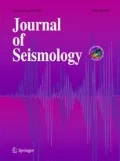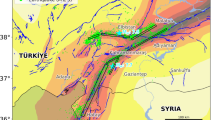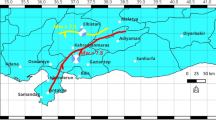Abstract
We have investigated earthquake source parameters and seismic moment-magnitude relations from 103 regional and local earthquakes with moment magnitude 2.6 to 7.2, which occurred in a distance range from 4.5 to 550 km during 1995–2012 by applying Brune’s seismic source model (J Geophys Res 75:4997–5009, 1970, J Geophys Res 76:5002, 1971) for P- and S/Lg-wave displacement spectra. Considering P- and S-wave data separately, we first studied the empirical dependence of the Fourier spectral amplitudes Ω due to the geometrical spreading and the inelastic attenuation and of the corner frequency, f 0, with the epicentral distances, R. We found the distance correction parameters, Re 0.0042R and R 0.8333 e 0.00365R for the low-frequency spectral amplitudes and f 0 = f ′0 e 0.00043R and f 0 = f ′0 e 0.00044R for the corner frequency at the source, f 0, and observed at the station, f ′0 , from P-wave and S-wave spectra, respectively. Applying the distance correction procedure, we determined the source displacement spectrum of P and S waves for each earthquake to estimate the seismic moment, M 0; the moment magnitude, M W; the source radius, r; and the stress drop, Δσ. The seismic moments range from 1.06 × 1013 to 7.67 × 1019 N m, and their corresponding moment magnitudes are in the range of 2.6–7.2. Values of stress drop Δσ vary from 0.1 to 44 MPa. It was found that the stress drop increases with the increasing seismic moment in the range of 1013–1016 N m and possibly becomes constant at higher magnitudes, reaching a maximum value of about 40–45 MPa. We demonstrate that the values of the M 0 and M W estimated from P-wave and S-wave analysis are consistent and confirmed by the results of waveform inversions, i.e., centroid moment tensor (CMT) solution.







Similar content being viewed by others
References
Al-Tarazi E, Sandvol E, Gomez F (2006) The February 11, 2004 Dead Sea earthquake ML=5.2 in Jordan and its tectonic implication. Tectonophysics 422:149–158
Allmann B, Shearer P (2009) Global variations of stress drop for moderate to larger earthquakes. J Geophys Res 114, B01310
Amiran D, Arieh E, Turcotte T (1994) Earthquakes in Israel and adjacent areas, macroscopic observations since 100 B.C.E. Israel Explor J 44:260–305
Archambeau CB (1966) General theory of elastodynamic source fields. Rev Geophys 6:241–288
Arieh E, Rotstein Y, Peled U (1982) The Dead Sea earthquake of April 23, 1979. Bull Seismol Soc Am 72:1627–1634
Ashkpour Motolagh S, Mostafazadeh M (2008) Source parameters of the Mw 5.8 Fin (south of Iran) earthquake of March 25, 2006. World Appl Sci J 4:104–115
Atkinson GM (1993) Earthquake source spectra in eastern North America. Bull Seismol Soc Am 83:1778–1798
Atkinson GM (2004) Empirical attenuation of ground-motion spectral amplitudes in southeastern Canada and the northeastern United States. Bull Seismol Soc Am 94:1079–1095
Avni R (1998) The 1927 Jericho earthquake, comprehensive macroseismic analysis based on contemporary sources. Ph.D. thesis, Univ. of Ben-Gurion, Israel, 211 pp. (in Hebrew with English abstract)
Baltay A, Ide S, Priet G, Beroza G (2011) Variability in earthquake stress drop and apparent stress. Geophys Res Lett 38:1–6. doi: 10.1029/2011GL046698
Baumbach M, Bormann P (1999) Determination of source parameters from seismic spectra. GeoForschugsZentrum Potsdam. International training courses on seismology and seismic risk assessment for developing countries
Baumbach M, Bormann P (2012) Determination of source parameters from seismic spectra. New manual of seismological observatory practice 2, Potsdam, Deutsches GeoForschugsZentrum, pp 1–7
Ben-Avraham Z, Garfunkel Z, Lazar M (2008) Geology and evolution of the Southern Dead Sea Fault with emphasis on subsurface structure. Annu Rev Earth Planet Sci 36:357–387. doi:10.1146/annurev.earth.36.031207.124201
Ben-Menahem A, Nur A, Vered M (1976) Tectonics, seismicity and structure of the Afro-Euroasian junction—the breaking of an incoherent plate. Phys Earth Planet Inter 12:1–50
Brune JN (1970) Tectonic stress and the spectra of seismic shear waves from earthquake. J Geophys Res 75:4997–5009
Brune JN (1971) Correction. J Geophys Res 76:5002
Drouet S, Bouin M, Cotton F (2011) New moment magnitude scale, evidence of stress drop magnitude scaling and stochastic ground motion model for the French West Indies. Geophys J Int 187:1625–1644
Garfunkel Z (2013) Overview of geological features of the Dead Sea transform. In: Garfunkel Z, Ben-Avraham Z, Kagan E (eds) The Dead Sea transform. Springer, Dordrecht
Hanks T, Boore D (1984) Moment-magnitude in theory and practice. J Geophys Res 89:6229–6235
Hanks T, Kanamori H (1979) A moment magnitude scale. J Geophys Res 84:2348–2350
Hanks T, Thatcher W (1972) A graphical representation of seismic source parameters. J Geophys Res 77:4393–4405
Hanks T, Wyss M (1972) The use of body-wave spectra in the determination of seismic-source parameters. Bull Seismol Soc Am 62:561–589
Havskov J, Ottemoeller L (2010) Routine data processing in earthquake seismology. Springer, Dordrecht, p 347. doi:10.1007/978-90-481-8697-6
Hofstetter A (2003) Seismic observations of the 22/11/1995 Gulf of Aqaba earthquake sequence. Tectonophysics 369:21–36
Hofstetter A, Shapira A (2000) Determination of earthquake energy release in the Eastern Mediterranean region. Geophys J Int 143:1–16
Hofstetter A, van Eck T, Shapira A (1996) Seismic activity along fault branches of the Dead Sea-Jordan transform system: the Carmel-Tirtza fault system. Tectonophysics 267:317–330
Hofstetter A, Thio HK, Shamir G (2003) Source mechanism of the 22/11/1995 Gulf of Aqaba earthquake and its aftershock sequence. J Seismol 7:99–114
Hofstetter A, Gitterman Y, Pinsky V, Kraeva N, Feldman L (2008) Seismological observation of the northern Dead Sea basin earthquake on 11 February 2004 and its associated activity. Isr J Earth Sci 57:101–124
Ide S, Beroza G (2001) Does apparent stress vary with earthquake size? Geophys Res Lett 28:3349–3352
Imanishi K, Ellsworth W (2006) Source scaling relationships of microearthquakes at Parkfield, CA determined using the SAFOD pilot hole array. In: Abercrombie R, McGarr A, Kanamori H, Toro G (eds) Earthquakes: radiated energy and the physics of earthquake faulting. American Geophysical Monograph 170:81–90
Kanamori H (1977) The energy release in great earthquakes. J Geophys Res 82:2981–2987
Kanamori H, Anderson D (1975) Theoretical basis of some empirical relations in seismology. Bull Seismol Soc Am 65:1073–1095
Kanamori H, Brodsky E (2004) The physics of earthquakes. Rep Prog Phys 67:1429–1496
Ken-Tor R, Agnon A, Enzel Y, Stein M, Marco S, Negendank J (2001) High-resolution geological record of historic earthquakes in the Dead Sea basin. J Geophys Res 106:2221–2234
Kiratzi A, Louvari E (2001) Source parameters of the Izmit-Bolu 1999 (Turkey) earthquake sequences from teleseismic data. Ann Geofis 44:33–47
Klinger Y, Rivera L, Haessler H, Maurin J-C (1999) Active faulting in the Gulf of Aqaba: new knowledge from Mw 7.3 earthquake of 22. Bull Seismol Soc Am 89:1025–1036
Malagnini L, Mayeda K (2008) High-stress strike-slip faults in the Apennines: An example from the 2002 San Giuliano earthquakes (southern Italy). Geophys Res Lett 35:L12302. doi:10.1029/2008GL034024
Mayeda K, Malagnini L, Walter W (2007) A new spectral ratio method using narrow band coda envelopes: evidence for non-self-similarity in the Hector Mine sequence. Geophys Res Lett 14:11303–11308
Meirova T, Hofstetter A (2012) Observations of seismic activity in southern Lebanon. J Seismol. doi:10.1007/s10950-012-9343-2
Migowski C, Agnon A, Bookman R, Negendank J, Stein M (2004) Recurrence pattern of Holocene earthquakes along the Dead Sea transform revealed by varve-counting and radiocarbon dating of lacustrine sediments. Earth Planet Sci Lett 222:301–314
Molnar P, Tucker B, Brune J (1973) Corner frequencies of P and S waves and models of earthquake sources. Bull Seismol Soc Am 63:2091–2104
Ottemoller L, Havskov J (2003) Moment magnitude determination for local and regional earthquakes based on source spectra. Bull Seismol Soc Am 93:203–214
Pinar A, Turkelli N (1997) Source inversion of the 1993 and 1995 Gulf of Aqaba earthquakes. Tectonophysics 283:279–288
Rebollar C (1985) Source parameters of the Ensenada Bay earthquake swarm, Baja California, Mexico. Can J Earth Sci 22:126–132
Salamon A, Hofstetter A, Garfunkel Z, Ron H (1996) Seismicity of Eastern Mediterranean region: perspective of the Sinai subplate. Tectonophysics 263:293–307
Salamon A, Hofstetter A, Garfunkel Z, Ron H (2003) Seismotectonics of the Sinai Subplate – The Eastern Mediterranean Region. Geophys J Int 155:149–173
Shamir G, Eyal Y, Bruner I (2006) Localized versus distributed shear in transform plate boundary zones: the case of the Dead Sea Transform in the Jericho Valley. Geochem Geophys Geosyst 6, Q05004. doi:10.1029/2004GC000751
Shapira A, Hofstetter A (1993) Source parameters and scaling relationship of earthquakes in Israel. Tectonophysics 217:217–226
Shapira A, Avni R, Nur A (1992) A new estimate for the epicenter of the Jericho earthquake of 11 July 1927. Isr J Earth Sci 42:93–96
Takahashi T, Sato H, Ohtake M, Obara K (2005) Scale dependence of apparent stress for earthquake along the subducting Pacific plate in northeastern Honshu, Japan. Bull Seismol Soc Am 95:1334–1345
Tan Y, Helmberger D (2007) A new method for determining small earthquake source parameters using short-period P waves. Bull Seismol Soc Am 97:1176–1195
Thatcher W, Hanks T (1973) Source parameters of southern California earthquakes. J Geophys Res 78:8547–8576
Tusa G, Gresta S (2008) Frequency-dependent attenuation of P waves and estimation of earthquake source parameters in southeastern Sicily, Italy. Bull Seismol Soc Am 98:2772–2794
Tusa G, Langer H, Brancato A, Gresta S (2012) High-frequency spectral decay in P-wave acceleration spectra and source parameters of microearthquakes in southeastern Sicily, Italy. Bull Seismol Soc Am 102:1796–1809. doi:10.1785/0120110206
van Eck T, Hofstetter A (1989) Microearthquake activity in the Dead Sea region. Geophys J Int 99:605–620
van Eck T, Hofstetter A (1990) Fault geometry and spatial clustering of microearthquake along the Dead Sea-Jordan rift fault zone. Tectonophysics 180:15–27
Walter W, Mayeda R, Gok R, Hofstetter A (2006) The scaling of seismic energy with moment: simple models compared with observations. In: Earthquakes: radiated energy and the physics of faulting. Geophys Monogr Ser 170:25–41
Watanabe K, Sato H, Kinoshita S, Ohtake M (1996) Source characteristics of small to moderate earthquakes in the Kanto region, Japan: application of a new definition of the S-wave time window length. Bull Seismol Soc Am 86:1284–1291
Wessel P, Smith W (1991) Free software helps maps and display data. EOS Trans AGU 72:441
Acknowledgments
The study was supported by the Earth Sciences and Research Administration, Ministry of Energy and Water, Israel. We thank the reviewers G. Tusa and L. Ottemoller and J. Zahradnik, editor, for useful and constructive comments that significantly improved the manuscript. Some figures in this study were prepared using the GMT program (Wessel and Smith 1991).
Author information
Authors and Affiliations
Corresponding author
Rights and permissions
About this article
Cite this article
Ataeva, G., Shapira, A. & Hofstetter, A. Determination of source parameters for local and regional earthquakes in Israel. J Seismol 19, 389–401 (2015). https://doi.org/10.1007/s10950-014-9472-x
Received:
Accepted:
Published:
Issue Date:
DOI: https://doi.org/10.1007/s10950-014-9472-x




